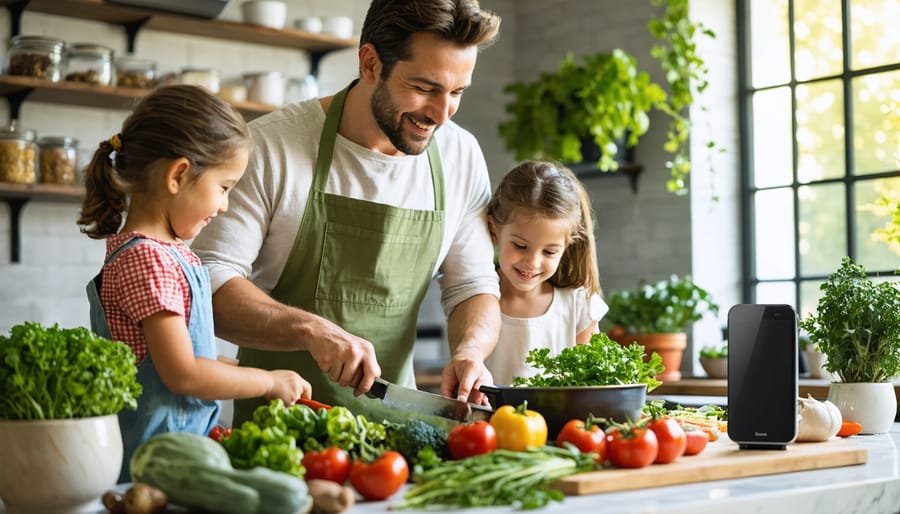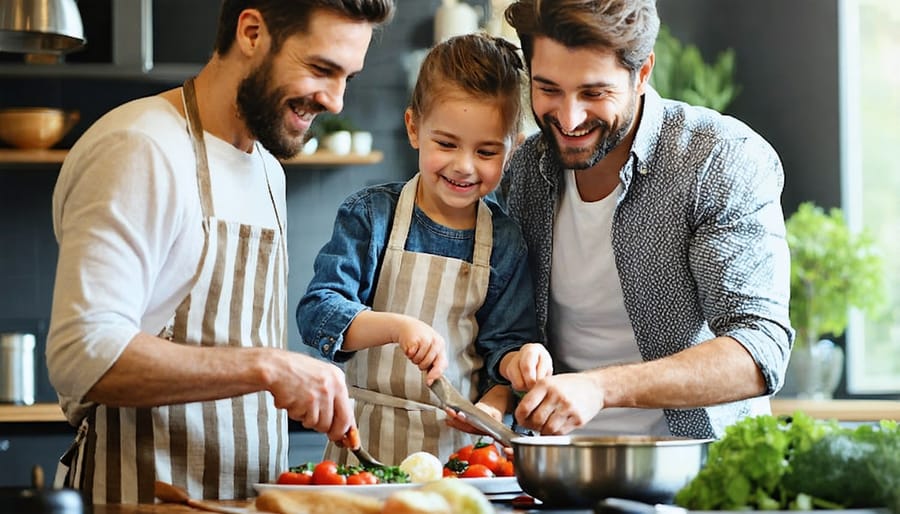
Transform your kitchen into a sanctuary of mindful well-being by embracing the simple power of present-moment cooking. In our fast-paced world, where meals often become just another task to check off our endless to-do lists, mindful cooking offers a revolutionary way to nourish both body and soul. Picture yourself chopping vegetables with intentional focus, breathing in the aromatic herbs, and feeling the warmth of a simmering pot – these everyday moments become gateways to deeper family connections and personal peace.
As a mother of three who once rushed through meal prep like a marathon, I’ve discovered that mindful cooking isn’t just about creating nutritious dishes; it’s about crafting precious moments of clarity, presence, and joy. When we approach our kitchen time with awareness, we transform routine meals into opportunities for meditation, family bonding, and genuine self-care.
This gentle practice doesn’t require extra hours or fancy techniques. Instead, it invites us to slow down, breathe deeply, and find beauty in the simple act of preparing food. Whether you’re a seasoned home chef or just beginning your culinary journey, mindful cooking offers a practical path to enhanced well-being that seamlessly fits into your daily routine.
The Heart of Mindful Cooking
Beyond the Recipe
Mindful cooking transcends the simple act of following recipe instructions – it’s about creating a sacred space where every chop, stir, and simmer becomes an opportunity for presence and connection. When we approach our kitchen time with intention, even the most mundane tasks transform into moments of meditation and self-care.
I remember the day I stopped rushing through dinner prep, constantly checking my phone between steps. Instead, I began noticing the vibrant colors of fresh vegetables, the satisfying sound of knife meeting cutting board, and the aromatic transformation of ingredients as they came together. This shift didn’t just improve my cooking – it changed my entire evening routine.
Try this: Next time you’re in the kitchen, take three deep breaths before beginning. Feel your feet grounded on the floor. Notice the weight of ingredients in your hands, the temperature changes as you cook, the evolution of aromas filling your space. This isn’t about perfection; it’s about being present in the process.
When we cook mindfully, we’re not just nourishing our bodies – we’re feeding our souls, creating memories, and building a deeper relationship with the food that sustains us.
Creating Sacred Kitchen Space
Your kitchen is more than just a place to prepare meals – it’s the heart of your home where memories are made and connections are strengthened. Creating a sacred kitchen space begins with decluttering and organizing your countertops, leaving only essential items that bring you joy and purpose. Consider adding elements that engage all senses: a small potted herb garden for fresh aromas, a bluetooth speaker for calming music, and warm, inviting lighting.
Make your kitchen a phone-free zone during meal prep and family dinners to encourage meaningful conversations. Set up a comfortable seating area where family members can chat while you cook, or better yet, invite them to join in the cooking process. A designated space for children to safely participate in meal preparation can transform everyday cooking into precious bonding moments.
Add personal touches that reflect your family’s values and heritage – perhaps a wall of beloved family recipes, a collection of inherited cooking tools, or artwork that celebrates food and togetherness. Remember, a sacred kitchen space isn’t about perfection; it’s about creating an environment that nurtures both body and soul while bringing your loved ones together.


Mindful Meal Planning for Family Joy
Seasonal Awareness
Being mindful of the seasons isn’t just about following trends – it’s about connecting deeply with nature’s rhythm and making conscious choices for our well-being. Choosing seasonal ingredients helps us stay grounded in the present moment while ensuring we get the most nutritional benefits from our food.
I’ve discovered that shopping seasonally has transformed my relationship with cooking. There’s something magical about anticipating the first spring asparagus or the late summer tomatoes. When we eat according to nature’s calendar, we’re not just nourishing our bodies – we’re participating in an age-old cycle that connects us to our environment and local community.
Consider starting a seasonal food journal to track what’s available in your area throughout the year. Notice how different ingredients make you feel, both physically and emotionally. Are you energized by fresh spring greens? Comforted by autumn squashes? This awareness helps create a more intentional approach to meal planning and cooking.
Local farmers’ markets are wonderful places to practice seasonal awareness. Strike up conversations with vendors about their growing practices and ask for cooking suggestions. These interactions not only enhance our understanding of where our food comes from but also strengthen our community bonds. Remember, eating seasonally doesn’t mean limiting yourself – it’s about celebrating the abundance each season brings to our tables.
Family Involvement
Transforming meal preparation into a mindful family activity can create beautiful moments of connection and learning. I remember how my own family’s dynamic shifted when we started involving everyone in our kitchen adventures – it became less about rushing through tasks and more about sharing experiences together.
Start by holding weekly family menu planning sessions where everyone gets to contribute ideas. Even young children can participate by drawing pictures of their favorite healthy meals or helping to clip recipe images from magazines. This inclusive approach helps family members feel valued and teaches the importance of balanced nutrition.
Make meal prep a mindful activity by assigning age-appropriate tasks to each family member. Little ones can wash vegetables or arrange ingredients, while older children might practice knife skills under supervision. Use this time to engage all the senses – discuss the colors of fresh produce, inhale the aromatic herbs, and share stories about favorite family recipes.
Create a peaceful kitchen atmosphere by playing soft background music and establishing a “present moment” rule – no phones or tablets during cooking time. This helps everyone stay focused on the task at hand and encourages meaningful conversations.
Remember to celebrate both the process and the result. Take photos of your collaborative cooking sessions, praise each person’s contribution, and express gratitude before eating. These mindful moments around food preparation strengthen family bonds and create lasting memories that nourish both body and soul.
Nurturing Connection Through Cooking
Mindful Kitchen Conversations
The kitchen has always been more than just a place to prepare meals – it’s a sanctuary where some of our most meaningful conversations unfold. When we combine cooking with mindful dialogue, we create opportunities for deeper connections and shared experiences that nourish both body and soul.
Start by setting an intention for your kitchen conversations. Maybe you’re cooking with your partner after a long day at work, or preparing Sunday breakfast with your children. Turn off your phone notifications and focus on being present with each other. As you chop vegetables or knead dough together, let the rhythmic nature of these tasks create a natural flow for conversation.
Ask open-ended questions that invite reflection and sharing: “What was the most interesting part of your day?” or “What are you looking forward to this week?” Listen actively, without rushing to respond or offer solutions. The simple act of stirring a pot or measuring ingredients can make these conversations feel more relaxed and natural.
Create special cooking rituals that encourage dialogue. Perhaps it’s “Taco Tuesday” where everyone shares their highs and lows while assembling their perfect taco, or a weekend baking session where family stories are shared alongside family recipes. These moments become treasured traditions that strengthen bonds while creating delicious meals.
Remember, some of life’s most honest and heartfelt conversations happen while cooking together. There’s something about the shared experience of creating a meal that opens hearts and minds, making space for authentic connection.
Sharing Food Stories
There’s something magical about gathering around a table and sharing not just food, but the stories behind each dish. Our family food traditions carry whispers of our heritage, love, and shared experiences.
Think about your grandmother’s signature dish – the one that fills your home with familiar aromas and instantly transports you back to childhood. These recipes aren’t just instructions on paper; they’re vessels of memory, carrying the laughter from past family gatherings and the wisdom passed down through generations.
Create a ritual of sharing these food stories during meal preparation. As you teach your children how to fold dumplings just like your mother taught you, or while you recreate your aunt’s secret sauce recipe, share the tales behind these dishes. Why was this recipe created? Who first brought it to the family? What celebrations was it part of?
Consider starting a family recipe journal where each member can contribute not just recipes, but the memories attached to them. Include photos, handwritten notes, and even pressed herbs from your garden. This becomes more than a cookbook – it’s a living document of your family’s journey through food.
Make mealtime a moment for storytelling. Turn off phones, gather around the table, and let conversations flow naturally. These shared moments of connection over food become the foundation of new memories and strengthen the bonds that make family meals so special.
Simple Practices for Mindful Family Meals
Gratitude Rituals
Before diving into our meals, taking a moment to pause and express gratitude can transform an ordinary dining experience into a meaningful ritual. As a busy mom, I’ve discovered that these small practices create powerful connections within our family and deepen our appreciation for the food we share.
Start by gathering everyone at the table without phones or distractions. Take three deep breaths together, allowing the aromas of the meal to fill your senses. Each family member can then share one thing they’re grateful for – it could be the hands that prepared the food, the farmers who grew the ingredients, or simply having loved ones present.
You might also consider creating a gratitude jar where family members drop notes of appreciation throughout the week, reading them together during weekend meals. Another beautiful practice is lighting a candle before eating, symbolizing the warmth and light that sharing meals brings to our lives.
Remember, these rituals don’t need to be elaborate or time-consuming. Even a simple moment of silent appreciation can help ground us in the present and foster a deeper connection to our food and loved ones.
Mindful Table Setting
Creating a mindful table setting isn’t just about aesthetics – it’s about crafting an environment that nurtures both body and soul. When I first started practicing mindful dining, I noticed how small changes to my table setting dramatically shifted the energy of my mealtimes.
Start by clearing away distractions. Remove phones, tablets, and any work-related items from the dining area. Instead, introduce elements that engage your senses positively. A simple centerpiece of fresh flowers or a potted herb can bring nature’s calming presence to your table.
Choose tableware thoughtfully. I love using plates with soft, muted colors that don’t compete with the food’s natural beauty. Simple, clean designs help maintain focus on the meal and your dining companions. Consider using cloth napkins – they not only elevate the experience but also add a sustainable touch to your routine.
Lighting plays a crucial role too. Dim overhead lights in favor of candles or soft accent lighting to create a peaceful atmosphere. This gentle ambiance naturally encourages slower, more mindful eating and meaningful conversation.
Remember, the goal isn’t perfection but creating a space that invites presence and connection. Even a few mindful touches can transform an ordinary meal into a nourishing ritual.

As we wrap up our journey into mindful well-being through cooking, remember that this practice isn’t about perfection – it’s about presence. Each time you step into your kitchen, you have an opportunity to transform a daily task into a moment of mindful connection with yourself and your loved ones.
Starting small is key. Perhaps begin with one mindful meal preparation per week, focusing on the sensory experience of chopping vegetables or the aromatic dance of herbs hitting a warm pan. Notice how this intentional approach not only enhances your cooking experience but also ripples into other areas of your life, bringing more awareness and joy to everyday moments.
I’ve witnessed countless women in our community discover that mindful cooking became their anchor in busy days, their moment of peaceful reflection amidst chaos. One reader shared how teaching her children to mindfully prepare simple meals together has become their favorite weekly ritual, strengthening their bond while creating lasting memories.
Remember, mindful well-being isn’t a destination – it’s a journey that evolves with you. Whether you’re preparing a quick breakfast or a elaborate dinner, each moment in the kitchen can be an opportunity for mindfulness practice. Start today, be patient with yourself, and watch how this simple shift in perspective can transform your relationship with cooking, nourishment, and overall well-being.
Let’s begin this beautiful journey together, one mindful meal at a time.



